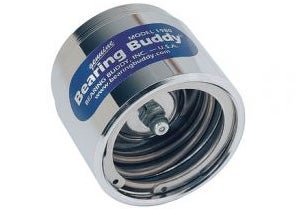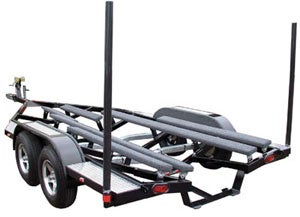How To Select Your Next PWC Trailer

What to look for in our PWC hauler
Sea-Doo’s entry into the trailer market raises some interesting questions about PWC trailers. Namely, what exactly do you need? For many of us, the answer is probably just a frame and a set of wheels to get us down the road. Buying a trailer, however, is a big decision. Make the correct one now and your purchase will be an investment that lasts many seasons…leaving you the money to use for better things.
Here’s a primer of what to look for when it comes time to shop for those wheels…that get you to the water.
Frame Material
Most standard PWC trailers are made of steel. It’s strong, its tubular design provides a pathway to protect wiring and possibly brake lines, and it can be painted to match your craft or tow vehicle. It’s also relatively inexpensive. The downside? It comes as no surprise to anyone that steel rusts. That pristine hauler today may look like a stained, aging rust bucket tomorrow. And with that rust comes some loss of structural integrity. Over time, it will compromise the strength of your trailer.

Galvanizing is an alternative to painting, and promises longer life and resistance to rust. Galvanizing involves dipping the steel into a bath of heated liquid zinc; once dry, it forms a silvery coating that resists rust and corrosion and is almost a must in a saltwater environment. The downside? It may look nice and shiny now, but down the road it too will age, dulling to a not-as-attractive silver finish.
Aluminum is a viable alternative to steel. Typically fabricated from I-beams, it’s very strong and lightweight, but offers less protection to wiring and brake lines. Aluminum is also typically more expensive.
Size

Take into account your boat’s “wet” weight when determining trailer capacity. Fuel weighs about 8.5 pounds per gallon. Other gear you’ve added to your storage compartments, or any on-trailer storage, also must be considered.
Suspension
Absorbing those bumps in the road is the job of your trailer’s suspension, typically leaf springs or torsion beams. Leaf springs are the cheapest and most common. They consist of curved steel plates, stacked atop each other, which flex to absorb shock. Torsion beam suspension opts for a “torsion” bar as the weight-bearing spring. A solid metal bar is fixed to the trailer frame; at the opposite end, a lever is attached to the axle. Providing the shock absorption are typically rubber cords placed inside the axle housing.
Hubs/Bearings

Hub bearings are typically protected by grease, packed inside the hub and forced into the bearings to prevent friction and heat build-up. An alternative system is oil bath lubrication, which uses a reservoir of oil to continually coat the bearings as they rotate.
Spring-loaded bearing protectors, like the Bearing Buddy, protect the bearings and keep grease contained, while allowing easy visual inspection of the grease level. Manufacturers claim the spring pressure also prevents water from entering the hub when submerged. A grease fitting allows more grease to be added without removing the hub.
Bunks or Rollers
Trailer bunks are most common, as they provide support along much of the entire length of the hull. Bunks are typically made from wood, covered in marine-grade carpet. Composite bunks are also available. Rollers typically provide easier loading and launching, particularly on gently sloped launch ramps, but often do not support the hull as well as a comparable bunk. Rollers may also dimple the hull. Check with your boat manufacturer, as they often suggest a certain type of trailer for best support.
Brakes

Laws vary by state, but typically brakes are required for all wheels on any trailer that grosses in excess of 3000 pounds. Hydraulic surge brakes are the most common trailer option, partly because they are far more tolerant of water than their electric alternative. Hydraulic surge brakes are activated by the change in momentum caused by the tow vehicle as it decelerates. The trailer’s momentum pushes the brake housing forward, which ultimately forces brake fluid out of the master cylinder and into the wheel cylinders, activating the trailer brakes. Surge systems can be used with either drum, or disc-style brakes.
Drum brakes work by forcing a pair of brake shoes against the side of an enclosed drum. Drums feature more parts, are typically harder to service, yet are relatively inexpensive. They may also be better for lighter trailer loads, as they don’t require the higher pressure of disc brakes, and often have more surface area on the pads. Many brake experts contend drums are better when the Gross Vehicle Weight (GVW) is under 3000 pounds. The primary disadvantage to drum brakes is that they contain water, possibly resulting in far faster corrosion and failure.
Disc brakes use hydraulic pressure to force a pair of brake pads to squeeze against a rotor, located behind the wheel hub. Discs are generally less complicated internally, require fewer adjustments, but more expensive up front. Disc brakes also feature no enclosed parts, making them far easier to rinse off at the end of the day with fresh water and less likely to suffer from rust and corrosion.
Trailers with drum brakes should have a hose connection to allow flushing the brake’s internal surfaces with fresh water. Essentially a system of tubing plumbed to a hose connection affixed to the trailer, a flush kit gets fresh water into areas that would normally be inaccessible to a hose, and greatly reduces the chance of rust and corrosion over time.
Winch

A trailer winch allows your PWC to be pulled up onto the trailer with relatively little effort, and also serves as a tie-down point for the bow once the boat is in place. Typically winches are mechanical, requiring a handle to be cranked to wheel the strap or cable onto the winch barrel.
Safety chain or cable is designed to run from the trailer tongue to the tow vehicle to prevent accident or injury in the unlikely event your trailer comes off the tow ball. Chains should be crisscrossed under the coupler, short enough to catch the tongue before it hits the pavement in the event of a failure, and feature beefy S hooks to secure to the cable attachments provided on the vehicle or hitch.
Tongue Jack
A tongue jack allows the tongue to be easily lifted and lowered on and off the hitch ball. Jacks typically feature a wheel at the base to allow the trailer to be moved about and positioned above the hitch ball. Jacks can also feature a solid foot pad to prevent the trailer from rolling.
LED Lights

LED lights are considered a vast improvement over low-tech, incandescent bulbs as they offer a far longer lifespan, can be sealed from water intrusion, use less energy, and are, on average, far brighter than incandescent bulbs.
Tires
Make sure your trailer tires are rated to carry the load of your fully loaded boat and trailer. Look at the tire’s Load Index, the last set of numbers following the tire’s size description. This number indicates the maximum weight a tire can support. Typically ranging from about 80 (a 992 pound load capacity) to 110 (2,337 pounds), make sure the cumulative total exceeds that of your load. That letter that follows the load index? It’s the tire’s maximum speed capability, typically between an R-S (106-112 mph) on most trailer tires.
Related Reading
2012 Sea-Doo PWC Trailer Line Review
2010 Sea-Doo ADVANCED TEC iCATCH I Trailer Review
Upgrading a PWC Trailer to LED Lighting
Safe Trailering for Personal Watercraft
Get PersonalWatercraft.com in your Inbox!
Like PersonalWatercraft.com on Facebook
Comments
Most Popular

2025 Yamaha JetBlaster PRO 2-Up Review

Remembering the Sea-Doo XP

2024 Kawasaki Jet Ski STX 160X Review

Whatever Happened to the Wetbike?

2025 Yamaha JetBlaster Review













 Your Privacy Choices
Your Privacy Choices